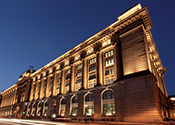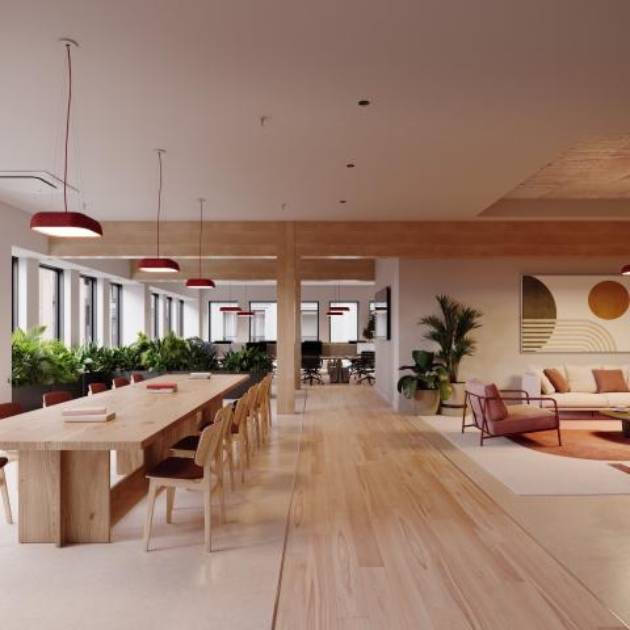Gilles Arpin, Lighting Designer: Revealing the Nature of Buildings

{loadposition slideShow5} Line Goyette
To say that Gilles Arpin is known is an understatement. He is familiar to everyone in lighting, and of course to our subscribers who read his column every month. Type lighting design key words into any search engine and his name is among the first entries to appear. If you watch the video accompanying this issue’s article on lighting the Jacques Cartier Bridge for the 375th anniversary celebrations, you’ll see Gilles Arpin.
He is also known in the neighbourhood where he has lived forever. At the corner restaurant where we meet, everyone is known by their first name. However, the homeless people sitting near us, whom he offers breakfast to, may not know he’s the same person who transformed the area near the entrance to the Mont-Royal metro, where every evening a van distributes food and comfort to troubled youth. “Lighting the façade of the Très-Saint-Sacrement monastery has changed the way people see this intersection. People used to avoid it. Now they stroll through it.” Safety, atmosphere and visual comfort are the core concepts in Arpin’s approach to lighting design.
Montreal by night looks the way it does in part because of Gilles Arpin, despite an impostor complex that came about from his years in show business. After completing his studies in urban planning — not architecture or engineering — Arpin quickly rose to the position of technical director and production manager, working with some of the biggest names in Quebec culture, such as Beau Dommage, les Grands Ballets Canadiens, and the Festival International de Jazz de Montréal.
Then, in 1996, Arpin collaborated with an architectural firm on a lighting plan for Old Montreal. “I found my place between the architect and the engineer, and I’ve stayed here ever since.” He travelled extensively and met with specialists and lighting designers who had a decisive influence on his work. “I began to get lighting projects in Paris. I learned much. I know today that creativity is not a function of technology or sensationalism.”
Arpin’s studies in urban planning added a theoretical framework to his pragmatic approach to lighting. “Light is a social being. Whether I am working on an interior or exterior project, I always ask myself the same question: what is the context? There are no absolute or universal solutions in lighting. One must first understand the symbolic value of the building or space that will be illuminated. Sometimes simplicity is the best choice.”
This minimalist concept leads us to speak of LED lighting and the new technologies that are rapidly developing. “Everyone is lighting more and more. I believe we should pay attention to the overuse of the light. I often work in large spaces and the level of illumination of the first building will often determine the levels for adjacent buildings. “Hôtel de Ville de Montréal is a good example of this choice and its influence on its surroundings.
“This building should be the best illuminated in Old Montréal because of its symbolic value. The lighting of the building had to reflect its sumptuousness.” Montrealers who were unaware of the whereabouts of the City Hall can now enjoy its architectural details at night. “The lighting must first be felt. It doesn’t always have to be spectacular. We hear about innovation in everything. Being innovative doesn’t mean just adding colour. Highlighting a building should help us appreciate the work of others. Don’t deconstruct buildings by illuminating them.”
Arpin also speaks about project costs. “It’s easy to use Photoshop images that give clients an eyeful, but one must be able to carry out a project within its budget. I work primarily in Montreal, where lighting maintenance budgets are not equal to those of some cities in the Middle East, for example. At the level of costs, what has changed is that lighting today is a capital expenditure. New lighting technologies allow for sustainable projects. Public lighting can last as long as a curb or a tree in urban areas.”
Arpin’s greatest professional pleasure is to see how urban lighting changes the way people make use of public places. And in his life, his greatest happiness is to share it with his life partner.
Appearing below is an overview of Gilles Arpin’s achievements, followed by awards earned throughout his career.
Line Goyette is Managing Editor of LDS; linegoyette@kerrwil.com.
MAIN ACHIEVEMENTS
Artworks
• Burning memory, Vieux-Montréal, Gilbert Boyer
• The Pointe-Saint-Charles by Gilles Mihalcean tip
• Vanes, Boul. Dufferin-Montmorency by Paul Béliveau
• Repair, Park Marcellin-Wilson, by Francine Larivée;
• Solstice, Maison Simons by Molinari;
• The Joust, Place Jean-Paul Riopelle by Jean-Paul Riopelle
Lighting plans and land use planning
Shoreline of Terrebonne
• Turcot interchange, Montreal
• Downsview Park, Toronto
• City of Oran, Algeria
• lighting Plan for Old Port of Montreal
• map light Street McGill
• Place Bourget, Joliette
• Portage Avenue, Winnipeg
• Royal Ontario Museum, Toronto
• Woodford Square, Port of Spain, Trinidad
• Site of the Saint Joseph’s oratory, Montreal
• boulevard Champlain promenade, Quebec
• Rehabilitation of the Concordia Campus downtown, Montréal
• Campus of science and campus Centre of UQAM
• Montreal International District
• Avenue-Honoré-Mercier, Quebec
• the Cité du multimédia, Montréal;
• esplanade, Parliament of Québec
• Lachine Canal heritage site, Montreal
• Trait-Carré de Charlesbourg, Quebec
• Pavillon des Sciences of UQAM, Vieux-Trois-Rivières campus.
Urban Illuminations
Montreal: The Pavilion Mordecai Richler
• Cabot Square
• Olympic Stadium Tower
• Place Canada
• Trois-Rivières sur Saint-Laurent,
• Tour de l’horloge, the tower and the beach
• the conveyor pier, Vieux-Port de Montréal
• Sun Life building • symphonic address, the Allan House
• Quartier des spectacles
• Park and space Hydro-Québec, entry Bonaventure, street McGill
• Square des Frères Charon
• monastery of très-Saint-Sacrement
• Campus of Sciences of UQAM
• IMAX old Port • McCord Museum
• Maison Saint-Gabriel
• Jacques-Cartier Bridge and its surroundings
• ,mausoleum of wood in the Marie-Reine-Du-Monde Cathedral
• Dalhousie station
• Eaton building wings, Rue Saint-Paul
• Rue municipality
• Place Jacques-Cartier
• Place d’Youville
• Montréal Hotel
• Lucien-Saulnier building
• Bonsecours Market
• Central Montreal Science interactive
• casino de Montréal (main entrance)
• Christ Church Cathedral
• Notre-Dame Basilica
• Place d’Armes
• Place Royale
• Museum of Pointe-à-Callière
• the chapel Notre-Dame-de-Bonsecours
• Monk bridge
• 1000 de la Gauchetière
City of Laval: Complex Centropolis
• Carrefour Boisbriand
Quebec City: House Hazeur Smith
• the site of the Trait-Carré (Charlesbourg)
• the Duplessis-Charest interchange
• Dufferin Boulevard
• monument to the Acadians
• the Coulée Verte
• Esplanade of the Parliament of Québec
Trois-Rivières: Theater 3rivieres on Saint-Laurent
• Manoir de Tonnoncourt
• Manoir Niverville
• Maison Hertel de la Fresnière
Sherbrooke: Island Frontenac.
Hull: Hull Casino and hotel complex
• Indoor parking from the Casino de Hull
Toronto: 300 Front Street
• Munk College of Foreign Affairs
• Union Station photometric daylight study
• Downsview Park Gateway
• Jarvis slip beach
• Royal Ontario Museum
• Manulife University Building
• York University, Glendon Campus new Hall
• Nocturnal branding for Ryerson University
Winnipeg: Bridge terrace Louis-Riel
• Upper Fort Garry site
• Downtown Business Improvement Zone
Interior Lighting
Montreal: The 2020 University
• the Carmel of Montreal
• Botanical Garden: greenhouse of Begonias
• Address Symphonique de Montréal
• YMCA Cartierville
• Jewish General Hospital
• Centura
• the Chapel of the Sacred Heart of the Basilica of Notre-Dame
• Eaton / wings, the city of trade electronics (public Halls)
• the Casino de Hull and hotel complex
• Hazeur Smith House
• La Bank Nationale du Canada (3 designs types for branches)
• Archambault Music Hall
• Halles d’ Anjou)
• 1,000 de la Gauchetière
Toronto: Manulife Centre Mall
• Royal Ontario Museum Main Hall
• York University, Glendon Campus new Hall
• Pusateri’s
Awards of Excellence
• IESNA 2015 Award of Merit, Montreal Olympic Stadium Tower
• IES Montréal 2014 Award light interior lighting for the chapel of the Carmel of Montreal
• IES Montréal 2014 Award light outdoor lighting for the dock of the clock du Vieux-Port de Montréal
• Association of landscape architects of Canada 2012 Master Plan of Dorchester and the Place of the Canada Square
• CSLA CSLA quote national – Square des Frères Charon
• IESNA International illumination design award 2007 EDZNA, Yuccatan Mexico
• Certificate of honour 2005 CSLA – Avenue Honoré-Mercier
• Award of excellence 2004 Hydro-Québec IDU – Quartier International de Montréal
• Light 2003 IES MONTREAL – Notre-Dame-De-Bonsecours Chapel
• Association of landscape architects of Canada 2002 old Montréal lighting Plan
• Light 2001 IES MONTREAL – Hôtel de Ville de Montréal Prize
• Reference to the Paul Waterbury 1997 – Casino de Hull award
• Honourable Mention at the Paul Waterbury 1990 price – 1,000 de la Gauchetière











